Polyester heaters also referred to as Polyester film heaters or Polyester foil heaters consist of an electrically conductive ink between two insulating respectively carrier layers of polyester. With a maximum size of 600 x 1000 mm, their average height is only 0.2 mm. As the picture examples show, practically any shape and type of cut-out is possible.
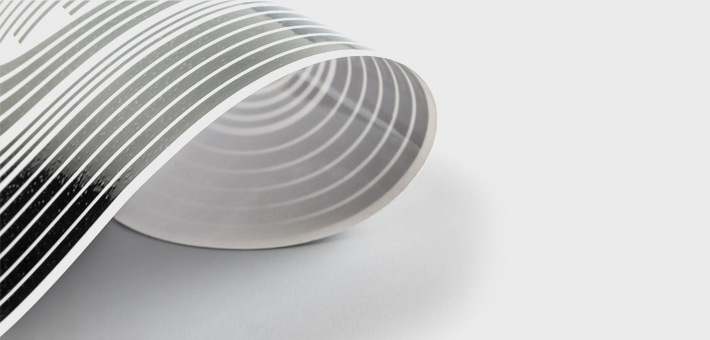

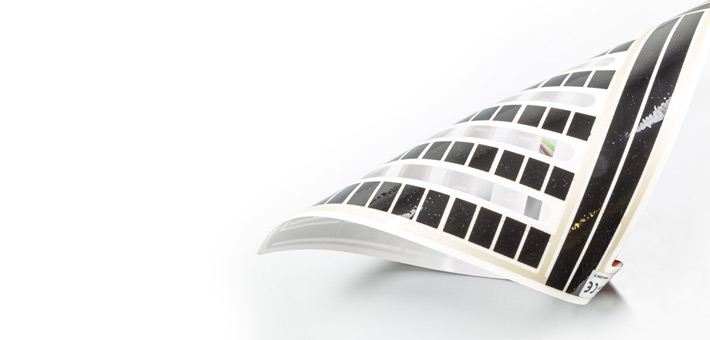

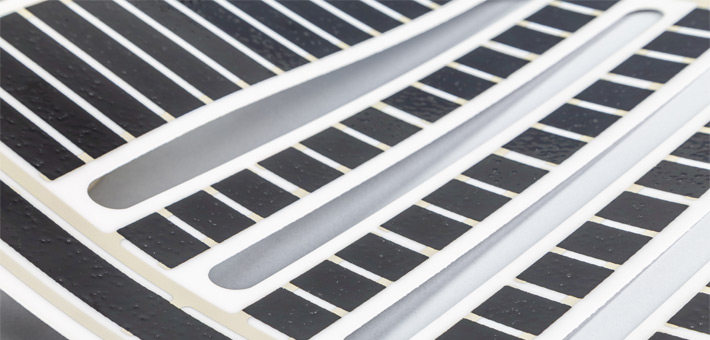
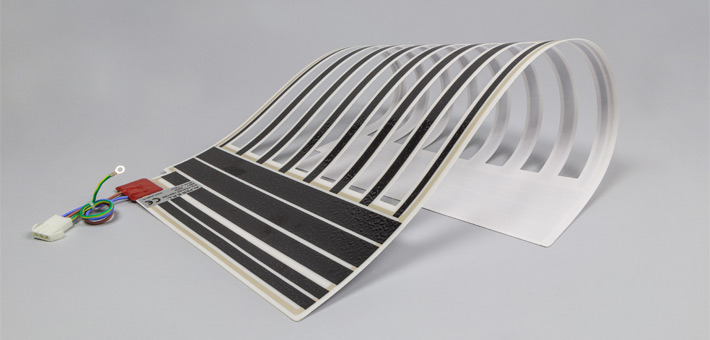
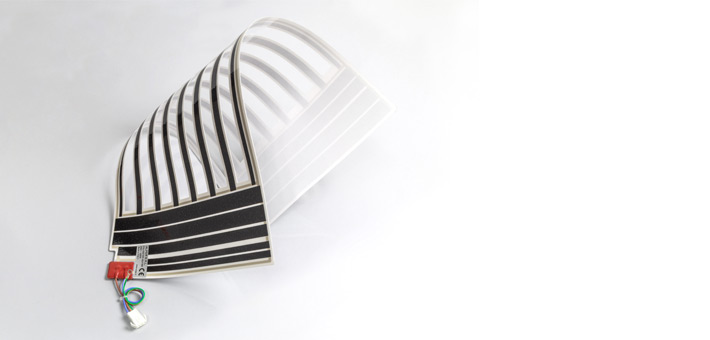
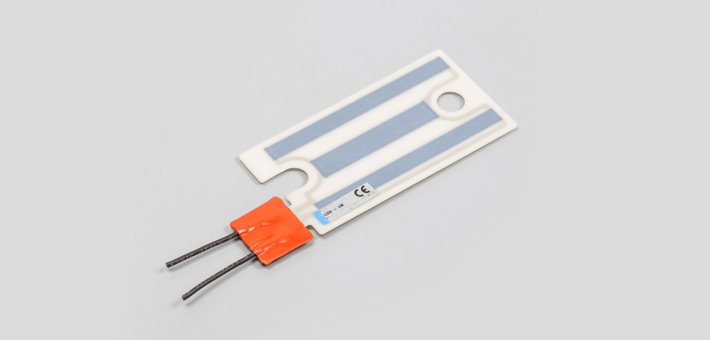

Polyester foil heaters are resistant to permanent temperatures of up to 90°C (max. 100°C for short periods). It is generally not possible to predict which temperature a Polyester heating element will reach in the application, as there are extremely many influencing factors. These include not only the power, but also the mass and type of goods to be heated, the ambient temperature, air currents, the type of mounting and, of course, the control technology.
As a rule of thumb: the lower the surface load on the Polyester foil heater, the longer the lifetime. We recommend a maximum surface load of 0.2 W/cm2 for polyester heaters.
Of course, safety and control elements such as temperature fuses, temperature limiters, thermocouples and resistance sensors can also be integrated into the design.
Due to their full-surface heating ink, Polyester heating foils are clearly superior to heating mats with wire wound or printed heating conductor tracks in terms of temperature profile, electromagnetic compatibility and immunity to interruptions. Also, minor damage to the ink does not automatically lead to failure of Polyester heating elements.
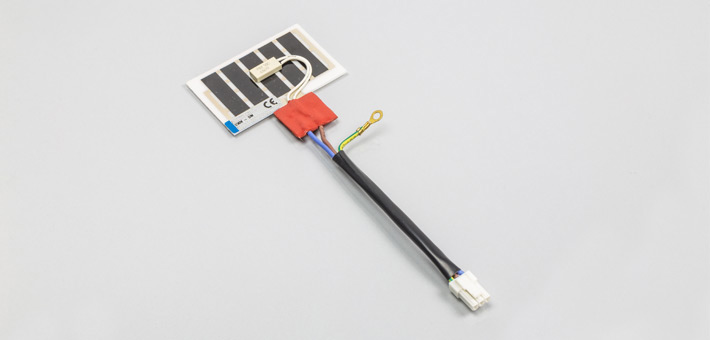

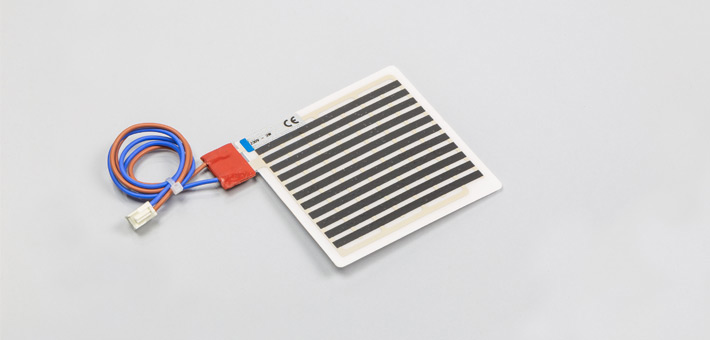
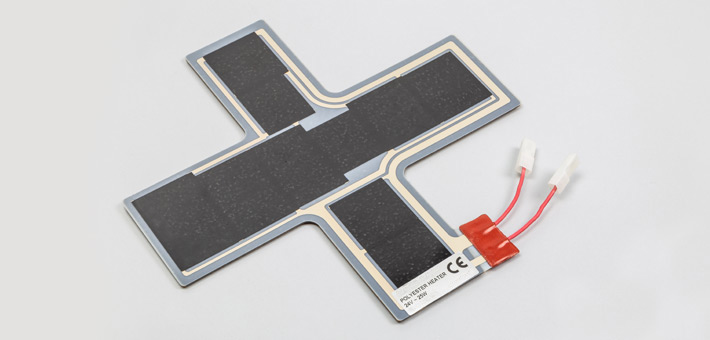
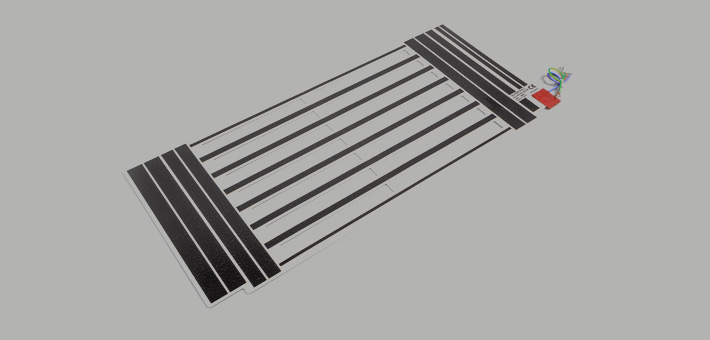
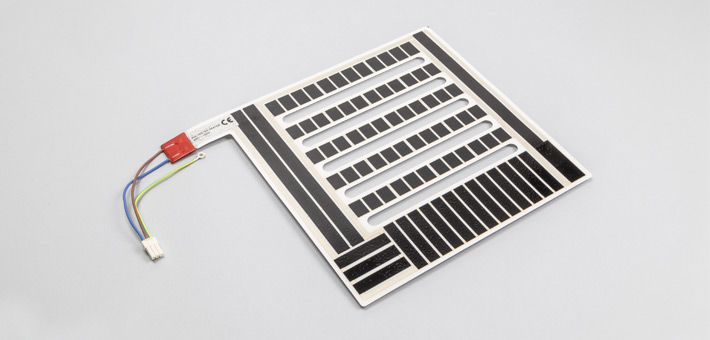
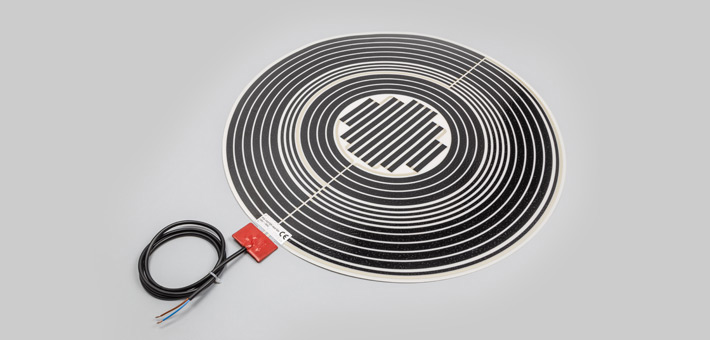
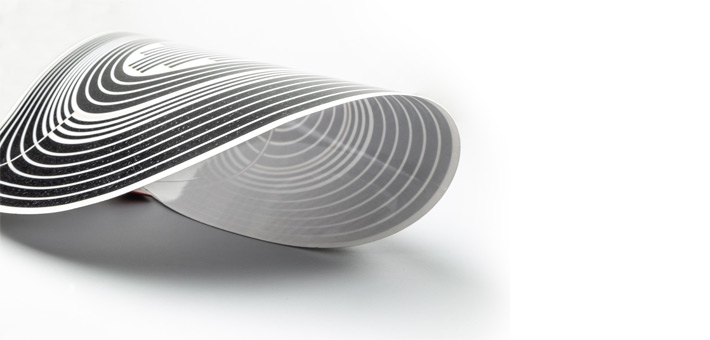
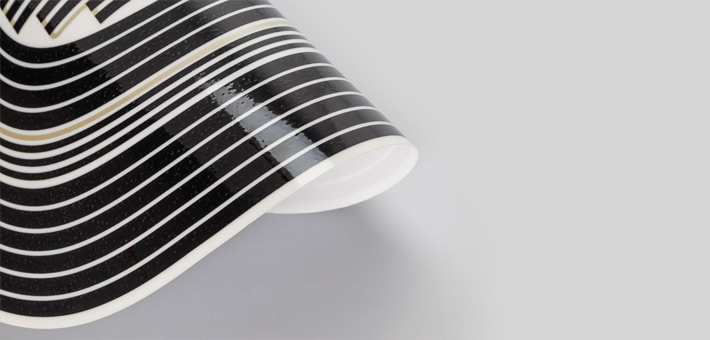
A further advantage of the heating ink is the easy realisation of power distributions across the heating surface: for this purpose, either the composition of the ink is varied or omissions are provided (see also the Polyester foil heater in the picture, with the dotted foil edges).
With the ink it is possible to install very low power on small areas even at 230 V. Here competing designs with resistance wire or etch foil quickly reach physical limits.
The flexible Polyester heater can be pressed on or fixed with a self-adhesive foil. Wrapped in PVC, it can also be used in liquids (IP67).
Typical applications for Polyester heaters are e.g. cup warmers in fully automatic coffee machines, mirror heaters, plate heat exchangers, flat applications with a target temperature below 90°C. Standards can be used for aquarium and terrarium heaters.
Technical data for Polyester Heaters vs. Silicone Heaters and Kapton Polyimide Heaters
| Flexible Heaters (up to 200°C) |
Flat Heating Elements (over 200°C) |
||||||||||||||||||||||||||||||||||||||||||||||||||||||||||||||||||||||||||||||||||||||||||||||||||
|---|---|---|---|---|---|---|---|---|---|---|---|---|---|---|---|---|---|---|---|---|---|---|---|---|---|---|---|---|---|---|---|---|---|---|---|---|---|---|---|---|---|---|---|---|---|---|---|---|---|---|---|---|---|---|---|---|---|---|---|---|---|---|---|---|---|---|---|---|---|---|---|---|---|---|---|---|---|---|---|---|---|---|---|---|---|---|---|---|---|---|---|---|---|---|---|---|---|---|---|
| Silicone | Kapton | Polyester | Micanite | Phlogopit | |||||||||||||||||||||||||||||||||||||||||||||||||||||||||||||||||||||||||||||||||||||||||||||||
| Wire Wound | Etched Foil | ||||||||||||||||||||||||||||||||||||||||||||||||||||||||||||||||||||||||||||||||||||||||||||||||||
| * higher surface loads can be achieved, depending on the application, with very good heat consumption and fast control (No warranty claims can be derived from this table) |
|||||||||||||||||||||||||||||||||||||||||||||||||||||||||||||||||||||||||||||||||||||||||||||||||||
| Continuous temperature resistance | -60 °C - 200 °C | -60 °C - 200 °C | -40 °C - 200 °C | -30 °C - 90 °C | 350 °C | 450 °C | |||||||||||||||||||||||||||||||||||||||||||||||||||||||||||||||||||||||||||||||||||||||||||||
| Continuous temperature resistance with self adhesive foil | -60 °C - 180 °C | -60 °C - 180 °C | -40 °C - 180 °C | -30 °C - 90 °C | - | - | |||||||||||||||||||||||||||||||||||||||||||||||||||||||||||||||||||||||||||||||||||||||||||||
| Short term temperature resistance | 250 °C | 200 °C | 200 °C | 100 °C | 700 °C | 900 °C | |||||||||||||||||||||||||||||||||||||||||||||||||||||||||||||||||||||||||||||||||||||||||||||
| Recommended max. watt density* | 0,8 W/cm² | 0,8 W/cm² | 0,8 W/cm² | 0,2 W/cm² | 4,0 W/cm² | 5,0 W/cm² | |||||||||||||||||||||||||||||||||||||||||||||||||||||||||||||||||||||||||||||||||||||||||||||
| Power tolerance | +5 / -10% | +5 / -10% | +5 / -10% | +/-10% | +5 / -10% | +5 / -10% | |||||||||||||||||||||||||||||||||||||||||||||||||||||||||||||||||||||||||||||||||||||||||||||
| max. dimension | 940 x 3000 mm | 595 x 2500 mm | 285 x 550 mm | 1000 x 600 mm | 2000 x 1000 mm | 2000 x 1000 mm | |||||||||||||||||||||||||||||||||||||||||||||||||||||||||||||||||||||||||||||||||||||||||||||
| min. dimension | 30 x 30 mm | 20 x 20 mm | 25 x 25 mm | 25 x 25 mm | 30 x 30 mm | 30 x 30 mm | |||||||||||||||||||||||||||||||||||||||||||||||||||||||||||||||||||||||||||||||||||||||||||||
| min. height | 1,1 - 3,0 mm | 0,8 - 1,5 mm | 0,2 mm | 0,2 mm | 2,0 mm (metal p.: 4,0 mm) |
2,0 mm (metal p.: 4,0 mm) |
|||||||||||||||||||||||||||||||||||||||||||||||||||||||||||||||||||||||||||||||||||||||||||||
| Dimension tolerance | +/- 1 mm | +/- 1 mm | +/- 1 mm | +/- 1 mm | +/- 1 mm | +/- 1 mm | |||||||||||||||||||||||||||||||||||||||||||||||||||||||||||||||||||||||||||||||||||||||||||||
| Quantities | from 1 piece | from 1 piece | from 1 piece | from 25 pieces | from 1 piece | from 1 piece | |||||||||||||||||||||||||||||||||||||||||||||||||||||||||||||||||||||||||||||||||||||||||||||
| min. bend radius | 5 mm | 5 mm | 2 mm | 5 mm | - | - | |||||||||||||||||||||||||||||||||||||||||||||||||||||||||||||||||||||||||||||||||||||||||||||
| max. IP-protection | IP65 | IP65 | IP64 | IP64 | - | - | |||||||||||||||||||||||||||||||||||||||||||||||||||||||||||||||||||||||||||||||||||||||||||||
| Adhesive foil possible | yes | yes | yes | yes | no | no | |||||||||||||||||||||||||||||||||||||||||||||||||||||||||||||||||||||||||||||||||||||||||||||
| UL possible | yes | yes | no | yes | no | no | |||||||||||||||||||||||||||||||||||||||||||||||||||||||||||||||||||||||||||||||||||||||||||||
Geometry of Polyester Heaters
For production reasons, the size of our flexible Polyester heaters is limited to a minimum of 25 x 25 mm and a maximum of 600 x 1000 mm. The minimum height is 0.2 mm. Within these dimensions, practically any shape and contour is possible, round, angular, with cut-outs and holes. Bending radii of min. 10 mm are possible with flexible Polyester film heaters.
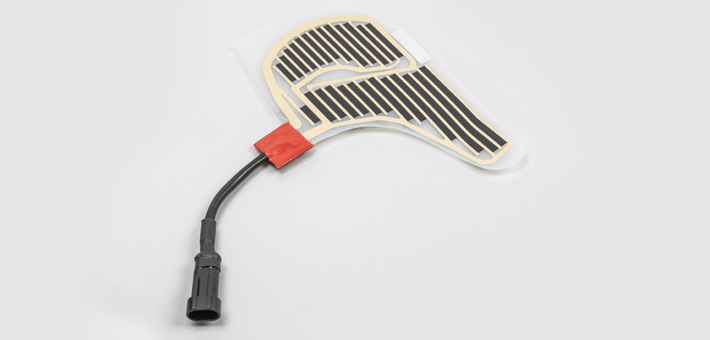


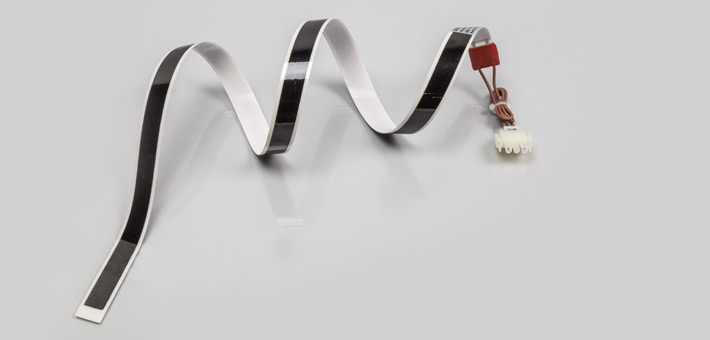

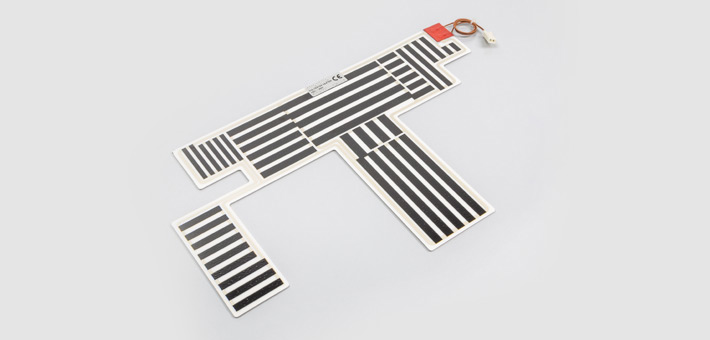
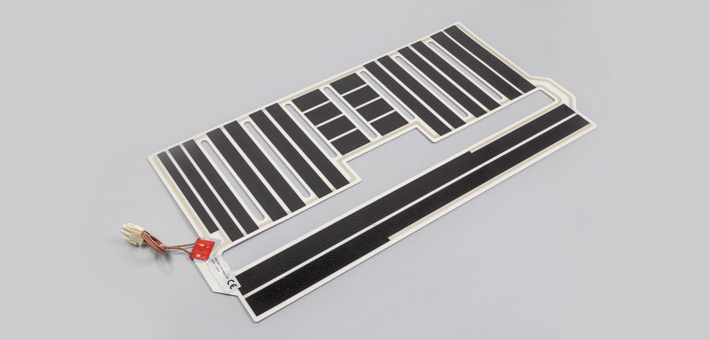
Manufacturing Process of Flexible Polyester Heaters
Polyester heaters are manufactured using the screen printing technology, whereby first silver-based conductor tracks are applied for contacting and then a layer of conductive resp. heating ink is applied. The large variety of different heating inks and the continuous search for new recipes allows the production and the development of new products to be adapted very flexibly to customer requirements.
This technology, which is unique in its kind, often makes it possible to achieve required performance adjustments (+/- 20%) simply by varying the heating ink, and thus to avoid tooling costs completely.
Due to their full-surface heating ink, Polyester film heaters are clearly superior to heating mats with wire winding or printed heating conductor tracks in terms of temperature profile, electromagnetic compatibility and immunity to interruptions.
A further advantage of the heating ink is the simple realisation of power distributions across the heating area: for this purpose, either the composition of the ink is varied or omissions are provided (see also the picture showing the Polyester film heater with the dotted foil edges).
As tooling costs are incurred for each Polyester heater design, they are usually used for quantities of 25 pieces and more. Due to automated production, Polyester heating elements are particularly suitable for the serial production of larger quantities (from 100 pieces on).
If they are to be used in liquids, the Polyester heating elements can also be welded into PVC. Thus a classification of IP 67 can be achieved.
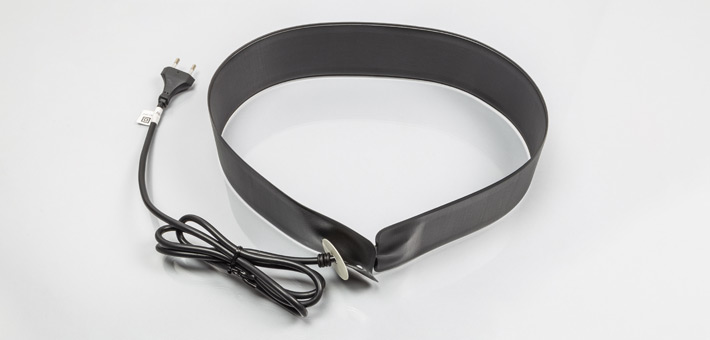
Self-Regulating PET Heater with PTC Ink
PET (polyester) heating elements are manufactured with a special carbon-based PTC ink. This ink exhibits a temperature-dependent increase in electrical resistance. The nominal power of such PTC foil heating elements (at room temperature) decreases inversely proportional to the increase in resistance (according to P=U²/R ) with increasing temperature and reaches a minimum at approx. 55°C or 85°C, depending on the PTC ink. This creates a balance of heat generation and heat dissipation and consequently a stable and safe operating temperature in the range of the respective resistance maximum or power minimum. The exact temperature at which the PTC foil heater ultimately regulates itself depends on the operating and ambient conditions of the application (heat conduction, insulation, ambient temperature, ventilation, etc.) and always requires a practical test under real operating conditions.
The PTC ink used for self-regulating PET (polyester) heating elements is screen-printed onto a flexible and ultra-thin PET substrate. This and their self-regulating properties make PET (polyester) heating elements with PTC ink particularly suitable for heating sensitive workpiece surfaces and materials where homogeneous and precise temperature control is important, as well as for applications where dangerous or critical temperatures must be effectively prevented. Self-regulating polyester film heating elements are preferably used as antifreeze heaters for batteries, as anti-condensation heaters for optics and electronic components, as well as for applications in which protection against contact with people must be guaranteed.
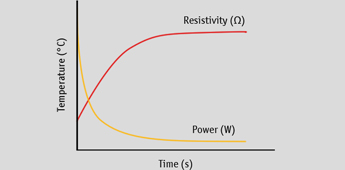
When the temperature of the PET foil heater with PTC self-regulating ink increases, the heating element increases its resistivity, hence decrease its power.
PTC Ink Printed Flexible Polyester Heaters Feature Intelligent Technology
Self-regulating Polyester (PET) heating elements printed with PTC ink do not need any temperature limiter. As the temperature rises the PTC ink increases its resistivity, hence reduces the power of the heating element. This immanent safety, plus the waiver of safety components allowing for a super-thin film heater design distinguishes these flexible Polyester heaters with PTC effect. They are outstanding features qualifying flexible PTC film heaters particularly for any application with contact to skin or textiles. On request the product can be produced with adhesive backing, even in part, and can be completed with any type of cable and connector.
Features of PTC Self-Regulating PET Heaters
- No external temperature limiter needed
- Two “self-limiting" temperatures are at choice:
- max. rise of resistance at 45°C (3V – 230V)
- max. rise of resistance at 85°C (3V – 230V)
- Safe! Advantageous for applications that get into contact with skin and/or textiles.
- Maximum dimensions: 1000 x 600 mm (customized sizes available on request)
- Heat uniformity through printed resistance ink
- Fast heat-up time
- Available with self-adhesive backing, even in part
- Design upon customer specification, allowing for all kinds of cut-outs and notches
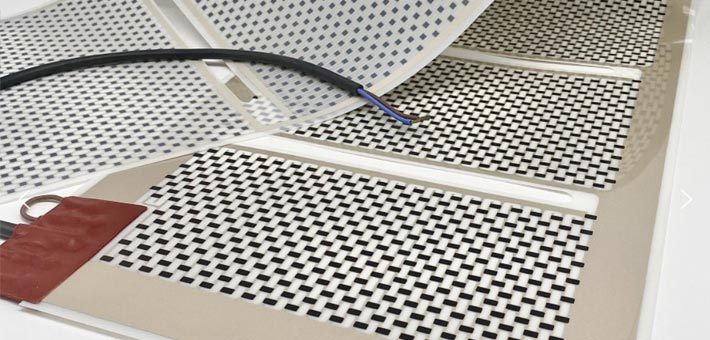

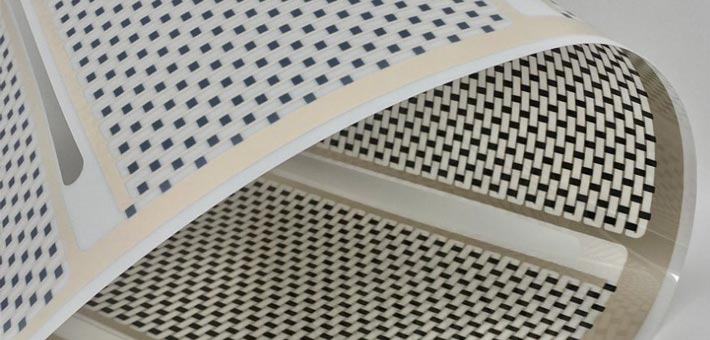
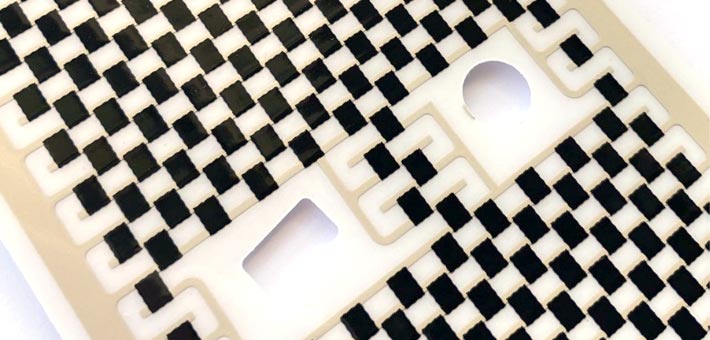

- max. rise of resistance at 45°C (3V – 230V)
- max. rise of resistance at 85°C (3V – 230V)




Mounting Options for Polyester Heaters
The flexible Polyester heater can be pressed on or bonded with self-adhesive foil. Once the heater is fixed with self-adhesive foil, it is not possible to remove it without destroying the heater.
self-adhesive foil
- not removable
- good heat transfer
- suitable for any shape and size
- download bonding instructions for flexible heaters here



Limiter, Thermocouple, Fuse, NTC,...
As with silicone heaters it is basically possible to attach limiters, thermocouples, fuses, etc. to the Polyester heater pad.
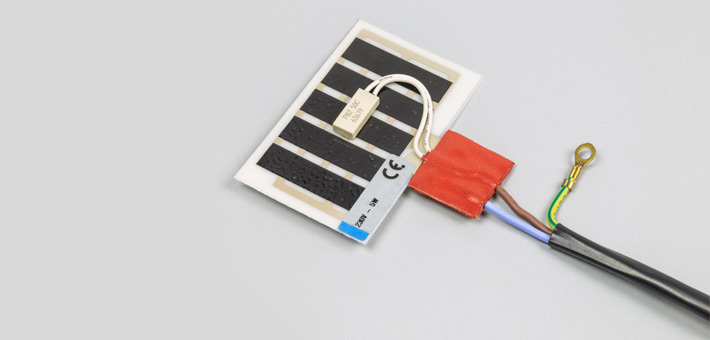
Aluminium Layer
In order to achieve an even more homogenous heat distribution, an aluminium foil can be laminated on one or both sides of the Polyester heater.
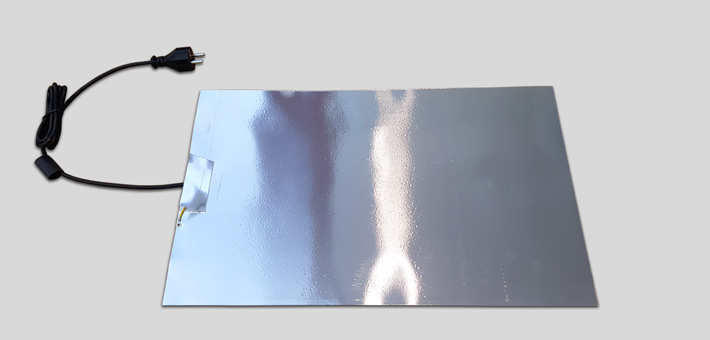

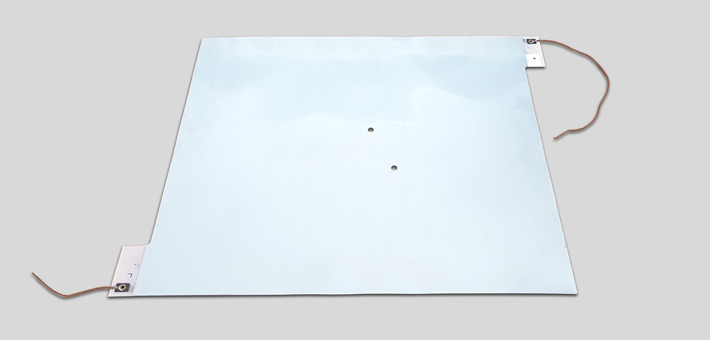
Connection
Termination below silicone patch
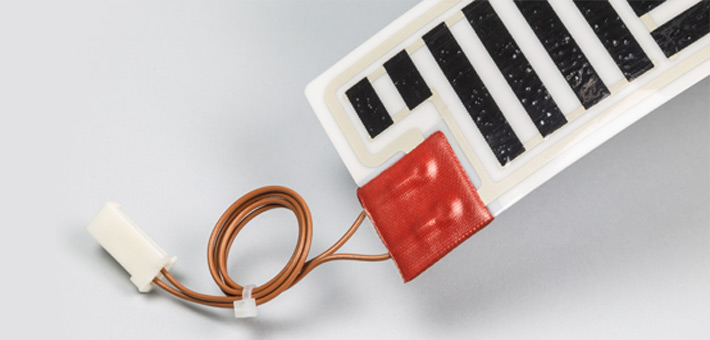
Termination below plastic housing
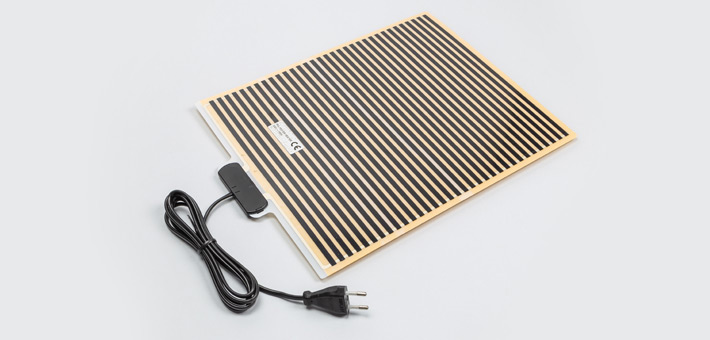
Termination with plug according to customer request

Molex-plug
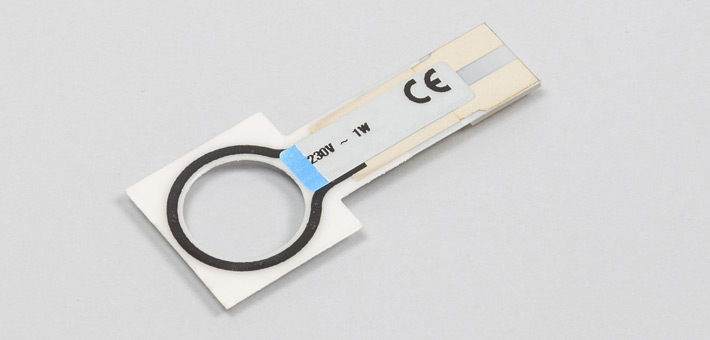
Power Leads for Polyester Heaters
Type, length and position of the leads can be freely selected. Please note that the connection area always has a slightly stronger build-up than the rest of the Polyester film heater. Silicone leads are most commonly used for Polyester heaters because they are light and flexible. PTFE, PVC and glass fibre leads are also possible. Often the contact is made on a tab outside the heating surface.
The length and type of the connecting leads can easily be changed for subsequent orders of an existing heater design. For a change of the connection position on the heater, however, a new tool must be created.
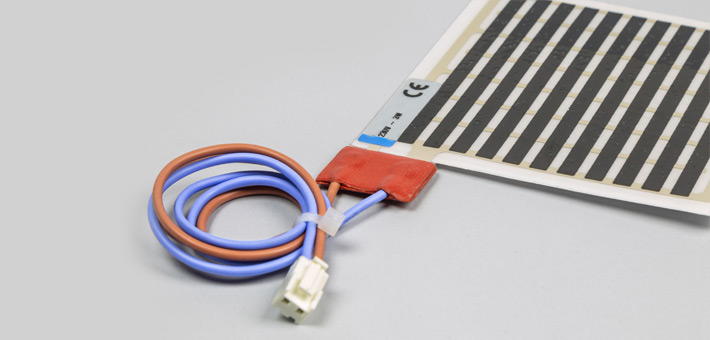
Protection Sleeve
In principle, it is possible to provide the connecting leads with a protection sleeve. However, fixing the sleeve results in a significantly thicker connection area.
Thermal protection also plays only a minor role due to the comparatively low operating temperatures of Polyester heaters. For mechanical protection, however, there are numerous alternatives from glass fibre sleeves to silicone sleeves to shrink sleeves.
Conformities & standards
Our Polyester heating elements are manufactured according to the strictest test criteria and meet all relevant standard and safety requirements as far as these are applicable due to the nature of the product. You will find general organisation or product group related certificates of conformity in our download centre under Service > Quality. Product-specific confirmations are available on request.
Certificates
- CE
- RoHS
- UL (Optional with surcharge, only possible with UL-CSA approved accessories)
- VDE (Optional with surcharge, only possible with VDE approved accessories)

Downloads:
-
Really hot! Our Product Flyer.

Download our leaflet here.
